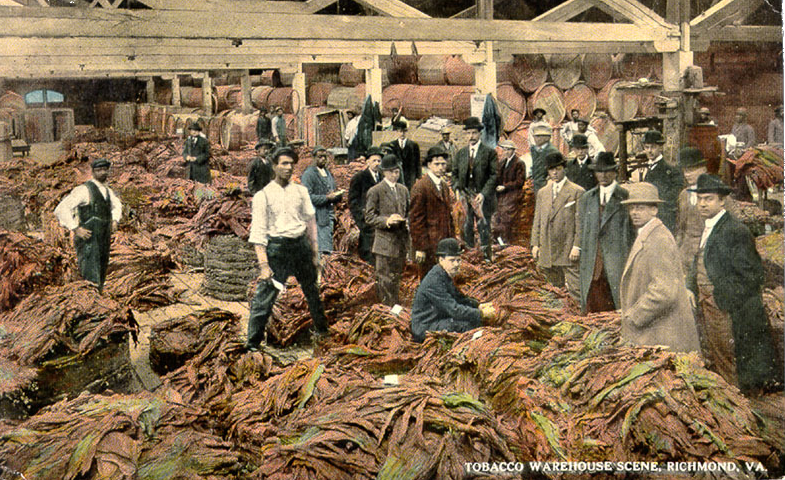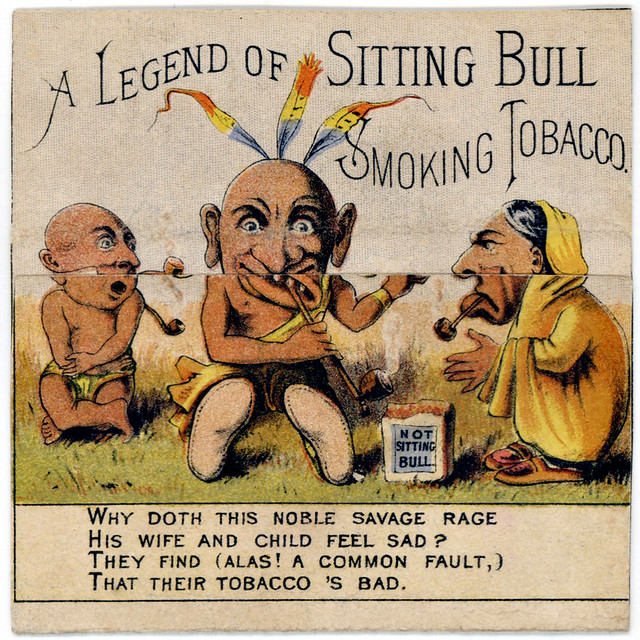
Tobacco Warehouse, Richmond, Virginia
As reported by CNN, "A brief history of tobacco," -- (CNN) -- Tobacco was first used by the peoples of the pre-Columbian Americas. Native Americans apparently cultivated the plant and smoked it in pipes for medicinal and ceremonial purposes.
Christopher Columbus brought a few tobacco leaves and seeds with him back to Europe, but most Europeans didn't get their first taste of tobacco until the mid-16th century, when adventurers and diplomats like France's Jean Nicot -- for whom nicotine is named -- began to popularize its use. Tobacco was introduced to France in 1556, Portugal in 1558, and Spain in 1559, and England in 1565.

The first successful commercial crop was cultivated in Virginia in 1612 by Englishman John Rolfe. Within seven years, it was the colony's largest export. Over the next two centuries, the growth of tobacco as a cash crop fueled the demand in North America for slave labor.
At first, tobacco was produced mainly for pipe-smoking, chewing, and snuff. Cigars didn't become popular until the early 1800s. Cigarettes, which had been around in crude form since the early 1600s, didn't become widely popular in the United States until after the Civil War, with the spread of "Bright" tobacco, a uniquely cured yellow leaf grown in Virginia and North Carolina. Cigarette sales surged again with the introduction of the "White Burley" tobacco leaf and the invention of the first practical cigarette-making machine, sponsored by tobacco baron James Buchanan "Buck" Duke, in the late 1880s.

Bull Durham Smoking Tobacco Ad
The negative health effects of tobacco were not initially known; in fact, most early European physicians subscribed to the Native American belief that tobacco can be an effective medicine.
By the early 20th century, with the growth in cigarette smoking, articles addressing the health effects of smoking began to appear in scientific and medical journals. In 1930, researchers in Cologne, Germany, made a statistical correlation between cancer and smoking. Eight years later, Dr. Raymond Pearl of Johns Hopkins University reported that smokers do not live as long as non-smokers. By 1944, the American Cancer Society began to warn about possible ill effects of smoking, although it admitted that "no definite evidence exists" linking smoking and lung cancer.

A statistical correlation between smoking and cancer had been demonstrated; but no causal relationship had been shown. More importantly, the general public knew little of the growing body of statistics.
That changed in 1952, when Reader's Digest published "Cancer by the Carton," an article detailing the dangers of smoking. The effect of the article was enormous: Similar reports began appearing in other periodicals, and the smoking public began to take notice. The following year, cigarette sales declined for the first time in over two decades.
The tobacco industry responded swiftly. By 1954 the major U.S. tobacco companies had formed the Tobacco Industry Research Council to counter the growing health concerns. With counsel from TIRC, tobacco companies began mass-marketing filtered cigarettes and low-tar formulations that promised a "healthier" smoke. The public responded, and soon sales were booming again.

The next big blow to the tobacco industry came in the early 1960s, with the formation of the Surgeon General's Advisory Committee on Smoking and Health. Convened in response to political pressures and a growing body of scientific evidence suggesting a causal relationship between smoking and cancer, the committee released a 387-page report in 1964 entitled "Smoking and Health." In unequivocal terms, it concluded that "cigarette smoking is causally related to lung cancer in men." It said that the data for women, "though less extensive, point in the same direction." The report noted that the average smoker is nine to 10 times more likely to get lung cancer than the average non-smoker and cited specific carcinogens in cigarette smoke, including cadmium, DDT, and arsenic.
The tobacco industry has been on the run -- albeit profitably -- ever since. In 1965, Congress passed the Federal Cigarette Labeling and Advertising Act requiring the surgeon general's warnings on all cigarette packages. In 1971, all broadcast advertising was banned. In 1990, smoking was banned on all interstate buses and all domestic airline flights lasting six hours or less. In 1994, Mississippi filed the first of 22 state lawsuits seeking to recoup millions of dollars from tobacco companies for smokers' Medicaid bills. And in 1995, President Clinton announced FDA plans to regulate tobacco, especially sales and advertising aimed at minors.

Tobacco has been around longer than the United States, and a causal relationship between smoking and cancer has been acknowledged by the U.S. government for over three decades. So why has it taken so long for the tobacco industry to be forced to settle lawsuits over the dangers of cigarettes?
Previous lawsuits went nowhere. Tobacco companies, with deep pockets for legal maneuvering, easily beat back early suits, including the first one, filed in 1954. Their most serious challenge before the 1990s came in 1983, when Rose Cipollone, a smoker dying from lung cancer, filed suit against Liggett Group, charging the company failed to warn her about the dangers of its products. Cipollone, who eventually died, initially won a $400,000 judgment against the company, but that was later overturned. After two arguments before the Supreme Court, Cipollone's family, unable to afford the cost of continued litigation, dropped the suit.

Now, however, tobacco companies face a different legal environment. Over the past three decades, the law has changed considerably.
Today, state laws and legal precedents hold manufacturers more liable for the effects of their products. And the old legal defense of "contributing negligence" -- which prevented lawsuits by people with some measure of responsibility for their own condition -- is no longer viable in most jurisdictions. Instead, a defendant can be held partially liable and forced to pay a corresponding percentage of damages. Finally, the notion of "strict" liability has developed; this means a defendant can be found liable whether or not they are found negligent. If a product such as tobacco causes harm, the company that produced it can be held responsible, even if it wasn't aware of the potential danger. (source: CNN © 2000 Cable News Network. All Rights Reserved.)

Find out how 1,000's of people like YOU are making a LIVING by staying home and are fulfilling their dreams right NOW.
ReplyDeleteGET FREE ACCESS INSTANLY